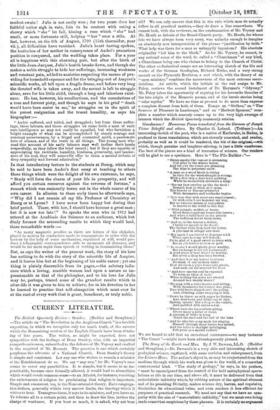The Stony of the Earth and Man. By J. W.
Dawson, LL.D. (Hodder and Stoughton.)—Dr. Dawson's is a very able and interesting sketch of geological science, reptinted, with some revision and enlargement, from the Leisure Hour. The author's object is, as may be conjectured from the medium through which his work_was given to the world, of a somewhat controversial kind. "The study of geology," he says, in his preface, "must be emancipated from the control of the bald metaphysical specu- lations so rife in our time, and above all, it must be delivered from that materialistic infidelity which, by robbing nature of the spiritual element and of its presiding Divinity, makes science dry, barren, and repulsive, diminishes its educational value, and even renders it less efficient for purposes of practical research. We need not say that we have no sym- pathy with the aim of "materialistic infidelity," but we must own-being made somewhat suspicious by these phrases. It is certainly no argument
against the truth of a theory that it makes "science dry, barren, and 'repulsive, and that it diminishes its educational value." At the same time, we quite concur in what is, we conceive, Dr. Dawson's general meaning, viz., the utter wrong of starting on scientific inquiry with an anti-religions object, a course quite as common, to say the least, as starting with theological prepossessions. Dr. Dawson takes special pains to argue against the extreme length claimed for the post-glacial period, and is probably right in alleging that the argument drawn from the time occupied by part of a deposit to that occupied by the whole is often extremely ffdleeious. He also makes a very vigorous opposition to the theories of evolution and natural selection. Hero is a passage which may serve as a specimen of his manner. The sentence which we have italicised seems to us a forcible illustration :—
"Even if we refuse to recognise all higher grounds of classification, and condescend, with some great zoologists of our time, to regard nature with the eyes of mere anatomists, or in the same way that a bricklayer's apprentice may be supposed to regard distinctions of architectural styles, we can arrive at no other conclusion [than that man ranks much higher above the apes than they rank above other mammals]. Let us imagine an anatomist, himself neither a man nor a monkey, but a being of some other grade, and altogether ignorant of the higher ends and powers of our species, to contemplate merely the skeleton of a man and that of an ape. He must necessarily deduce therefrom an ordinal distinction, even on the one ground of the correlations and modifications of structure im- plied in the erect position. It would, indeed, be sufficient for this purpose to consider merely the balancing of the skull on the neck, or the structure of the foot, and the censequencos fairly deducible from either of them. Nay, were such imaginary anatomist a derivationist and ignorant of the geological date of his specimens, and as careless of the differeacee between them as some of his human- coefrires, he might, referring to the less specialised condition of man's tooth and foot,



































 Previous page
Previous page